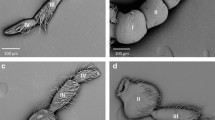Summary
The whip spiderHeterophrynus longicornis uses cuticular hair sensilla for orientation. Bristles and trichobothria occur mainly on the walking legs. The first pair of legs, which are modified appendages, bear five additional types of sensilla as well as three other sensory structures.
The hair sensilla of different developmental stages were studied by light- and scanning electron microscopy for quantitative evaluations. Transmission electron microscopy permitted to attribute the following tentative functions to certain sensilla: bristles — contact chemoreception and mechanoreception; trichobothria — mechanoreception (‘touch-at-a-distance’); porous sensilla (2 types)— olfaction; club sensilla — chemoreception (hygroreception?); rod sensilla — chemoreceptors. The modified claws, the ‘pit organ’ and the ‘plate organ’ are supposedly also chemoreceptors (eventually humidity and/or thermoreceptors).
Based on the number of sensilla on the tarsus of a first leg we calculated a theoretical number of 2250 axons for the first tarsal segment and 21 500 axons for the level of the last tarsal segment. Actual counts done on EM-pictures yielded very similar numbers. This means that practically all nerve fibres (0.2/gmm diameter) are afferent and that all of them proceed toward the CNS. Furthermore, each tarsal nerve contains one or several giant fibres (10–20Μm diameter) which receive synapses from small axons already in the distalmost segment 1. We interpret this findings as a fast conduction pathway to relate peripheral stimuli quickly to the CNS.
A comparison with the few studies on other Amblypygi renders it likely that their sensory equipment is rather similar, which corresponds to their similar life habits.
Zusammenfassung
Die Gei\elspinneHeterophrynus longicornis orientiert sich überwiegend mit Hilfe von cuticularen Haarsensillen. Borstenhaare und Trichobothrien treten besonders an den Beinen auf. Das zu einem Tastbein umgeformte, vielfach gegliederte 1. Beinpaar trÄgt au\erdem 5 weitere Typen von Haarsensillen- und 3 anders gestaltete cuticulare Sinnesorgane.
Die Haarsensillen der verschiedenen Entwicklungsstadien der Gei\elspinne wurden licht und rasterelektronenmikroskopisch untersucht und ausgezÄhlt. Anschlie\ende elektronenmikroskopische Untersuchungen erlauben die Zuordnung folgender physiologischer Funktionen: Borstenhaare — Kontaktchemo- und Mechanorezeptoren; Trichobothrien — Mechanorezeptoren („Ferntastsinnesorgane“); Porenhaare (2 Typen) — olfaktorische Chemorezeptoren; Kölbchenhaare — Chemorezeptoren i.w.S. (auch hygrosensitiv?); StÄbchenhaare (2 Typen) — Chemorezeptoren i.w.S. Die umgeformten Krallen sowie das „Gruben“- und das „Plattenorgan“ sind vermutlich ebenfalls Chemorezeptoren i.w.S. (auch hygro-thermosensitiv?).
Aus der Anzahl der Sensillen des Tastbeintarsus ergibt sich eine theoretische Axonzahl von 2250 an der Spitze bzw. 21 500 an der Basis. AuszÄhlungen von EM-Schnittbildern stimmen damit gut überein. Alle Fasern (Φ um 0,2 Μm) sind wahrscheinlich afferent und ziehen getrennt zum ZNS. Daneben finden sich in jedem Tarsalnerv eine oder mehrere Riesenfasern (Φ 10–20Μm), auf die kleinere Axone bereits vom Glied 1 an aufgeschaltet werden. Wahrscheinlich handelt es sich hier um ein „Schnelleitsystem“, das periphere Reize möglichst rasch zum ZNS bringt.
Ein Vergleich mit Untersuchungen an anderen Arten macht wahrscheinlich, da\ die Ausstattung mit Sinnesorganen innerhalb der Ordnung Amblypygi sehr Ähnlich ist und damit der Ähnlichen Lebensweise der Arten entspricht.
Similar content being viewed by others
Literatur
Barth, F.G., Stagl, J.: The slit sense organs of Arachnids. A comparative study to their topography on the walking legs (Chelicerata, Arachnida). Zoomorphologie86, 1–23 (1976)
Beck, L.: Zur Tagesperiodik der LaufaktivitÄt vonAdmetus pumilio C. Koch (Arach., Amblypygi) aus dem neotropischen Regenwald. II. Oecologia (Berl.)9, 65–102 (1972)
Beck, L., Foelix, R., Gödeke, E., Kaiser, R.: über die Haarsensillen der Gei\elspinneAdmetus pumilio (Arach., Amblypygi). Naturwissenschaften61, 327–328 (1974)
Beck, L., Görke, K.: Tagesperiodik, Revierverhalten und Beutefang der Gei\elspinneAdmetus pumilio C.L. Koch im Freiland. Z. Tierpsychol.35, 173–186 (1974)
Delle Cave, L.: On some sense organs on the first pair of legs ofDamon diadema Simon 1876 (Amblypygi, Arachnida). Monit. Zool. Ital. (N.S.)9, 203–211 (1975)
Foelix, R.F.: Occurrence of synapses in peripheral sensory nerves of arachnids. Nature254, 146–148 (1975)
Foelix, R.F.: Rezeptoren und periphere synaptische Verschaltungen bei verschiedenen Arachnida. Ent. Germ.3, 83–87 (1976)
Foelix, R.F., Axtell, R.C.: Ultrastructure of Haller's organ in the tickAmblyomma americanum (L.). Z. Zellforsch. mikrosk. Anat.124, 275–292 (1972)
Foelix, R.F., Chu-Wang, I.W.:The morphology of spider sensilla. I. Mechanoreceptors. Tissue Cell5, 451–460 (1973)
Foelix, R.F., Chu-Wang, I.W.: The morphology of spider sensilla. II. Chemoreceptors. Tissue Cell5, 461–478 (1973)
Foelix, R.F., Chu-Wang, I.W., Beck, L.: Fine structure of tarsal sensory organs in the whip spiderAdmetus pumilio (Amblypygi, Arachnida). Tissue Cell7, 331–346 (1975)
Gödeke, E., Kaiser, R.: Verteilung und Entwicklung der Haarsensillen des Tastbeinpaares der Gei\elspinneAdmetus pumilio C. L. Koch (Arachnida, Amblypygi) und übersicht über den Bau ihres Zentralnervensystems. Diplomarbeit, Bochum (1975)
Görke, K.: Freilandbeobachtungen und verhaltensphysiologische Untersuchungen zur Biologie der Gei\elspinneAdmetus pumilio C.L. Koch. Diplomarbeit, Bochum (1973)
Kaissling, K.-E.: Handbook of sensory physiology, Vol. 4, Chemical senses, Part 1, Olfaction (L.M. Beidler, ed.), pp 451–431. Berlin-Heidelberg-New York: Springer 1971
Quintero, D.: Scanning electron microscope observations on the tarsi of the legs of Amblypygids (Arachnida Amblypygi). Proc. 6th. Int. Arachnol. Congress 1974, pp. 161–163 (1975)
Schneider, D., Kasang, G., Kaissling, K.-E.: Bestimmung der Riechschwelle vonBombyx mori mit Tritium-markiertem Bombykol. Naturwissenschaften55, 395 (1968)
Slifer, E.H.: The structure of arthropod chemoreceptors. Ann. Rev. Ent.15, 121–142(1970)
Steinbrecht, R.A.: Comparative morphology of olfactory receptors. In: Olfaction and taste (C. Pfaffmann, ed.), pp. 3–21. New York: Rockefeller University Press 1969
Steinbrecht, R.A.: Zur Morphometrie der Antenne des SeidenspinnersBombyx mori L.: Zahl und Verteilung der Riechsensillen (Insecta, Lepidoptera). Z. Morph. Tiere68, 93–126 (1970)
Waldow, U.: Elektrophysiologische Untersuchungen an Feuchte-, Trocken- und KÄlterezeptoren auf der Antenne der WanderheuschreckeLocusta. Z. vergl. Physiol.69, 249–283 (1970)
Weygoldt, P.: Lebenszyklus und postembryonale Entwicklung der Gei\elspinneTarantula marginemaculata C.L. Koch (Chelicerata, Amblypygi) im Laboratorium. Z. Morph. Tiere67, 58–85 (1970)
Weygoldt, P.: Gei\elskorpione und Gei\elspinnen (Uropygi und Amblypygi). Z. Kölner Zoo15, 95–107 (1972)
Weygoldt, P.: Vergleichende Untersuchungen an zweiHeterophrynus-(Admetus)-Arten,H. longicornis Butler undH. batesii Butler (Arachnida, Amblypygi, Tarantulidae). Zool. Anz. Jena192, 175–191 (1974)
Author information
Authors and Affiliations
Additional information
Mit Unterstützung der Deutschen Forschungsgemeinschaft
Rights and permissions
About this article
Cite this article
Beck, L., Foelix, R., Gödeke, E. et al. Morphologie, Larvalentwicklung und Haarsensillen des Tastbeinpaares der Gei\elspinneHeterophrynus longicornis Butler (Arach., Amblypygi). Zoomorphologie 88, 259–276 (1977). https://doi.org/10.1007/BF00995476
Received:
Issue Date:
DOI: https://doi.org/10.1007/BF00995476




